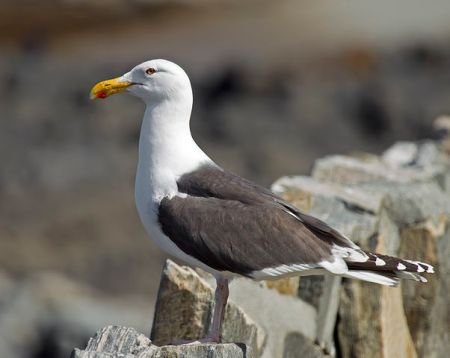Last week I gave you this unidentified skull from the Dead Zoo to have a go at identifying:

It seems that everyone recognised this as the skull of a gull straightaway – the scars from the salt-glands on the top of the head and the shape of the bill combined to make it a bit of a give-away.
However, working out which species of gull is a bit more tricky, since many are remarkably similar in morphology, making size an important factor for consideration (I’ve talked about this before).
Now size is always a somewhat tricky thing to use for identification, for a variety of reasons. One is that there may be an overlap in size between species, another is that there will often be sexual dimorphism within a species that means you can’t just compare the length against another specimen of a species without considering sex. Then of course there’s age – if it’s not fully grown, it’s going to be smaller. Of course you also have to consider whether the bill sheath is present or absent, as this will add a few millimetres.
On top of all these issues, there’s the problem of how you actually measure the length in the first place. This is something I’ve researched in the past (link to pdf) and it’s a more significant problem than you might think. For example, when looking at the image I originally provided for the mystery object, it looks like the skull measures around 125mm, but if I chop the scale bar from the image, reduce the transparency to 50% and lay it directly over the centreline of the image of the specimen, it turns out to be around 128mm.

Length is apparently 128mm
Add to this the fact that in the original image you can see a shadow under the scale bar, it becomes clear that the scale is somewhat elevated. This is because I raise the scale to be near the vertical midline of the specimen, to help keep everything in focus and limit the effect of parallax error. Normally this is good, because it allows a more accurate estimation of the length of a 3D specimen with a longest axis near the vertical midline, but in this case the longest part of the specimen is actually at the lowest part of the skull, so the elevated scale will make it look slightly shorter than it really is (due to the parallax error I was hoping to avoid…). This means that the specimen is probably closer to 129mm or 130mm in length.
With this in mind, the discussion about the lengths of various gull skulls between Wouter van Gestle (of Skullsite fame), Ric, Tim Dixon, Richard Lawrence, Gerard van den Brink and jennifermacaire needs to be reconsidered.
Richard Lawrence reported skull lengths for a variety of gulls as follows:
6x GBBG: 129 to 141 mm
2x LBBG: 117 mm
6x HG: 111 to 117mm
9x YLG: 111 to 126 mm ( larger with beak sheath though so would be smaller without).
So factoring in a length of 129-130mm for the mystery object it seems to fit well into the range for the Great Black-backed Gull Larus marinus Linnaeus, 1758. So well done to everyone who went for GBBG – this does seem most likely to be a skull from the largest gull species.


another grand adventure in osteology provided by mr paolo!
thanks for the insight on the difficulties associated with measurement of skulls. every year my students struggle with agreement on length and width of their specimens, problems arising from the issues you raise. this gives me more ideas to help them.
much thanks and happy holidays everyone!
Shoot: GBBG was my first guess! Happy Christmas, Paolo and everyone.
Merry Christmas everyone!
Wishing everyone a very Merry Christmas season!
Merry Christmas everyone!